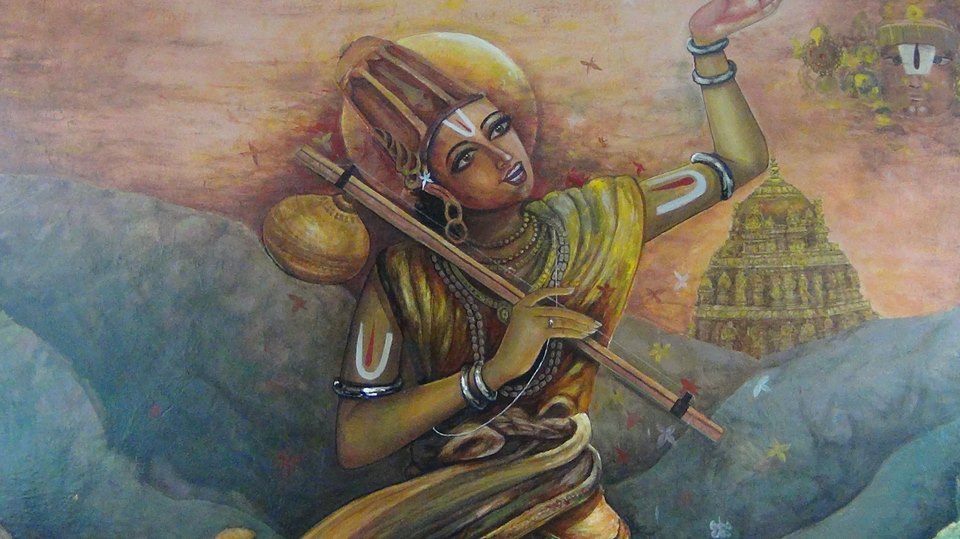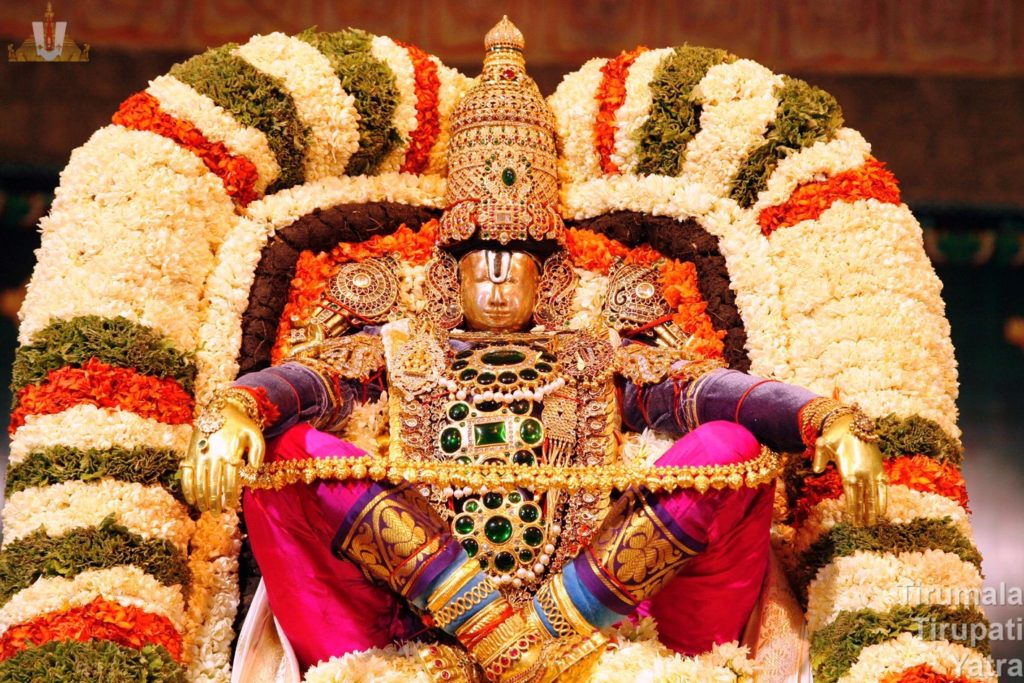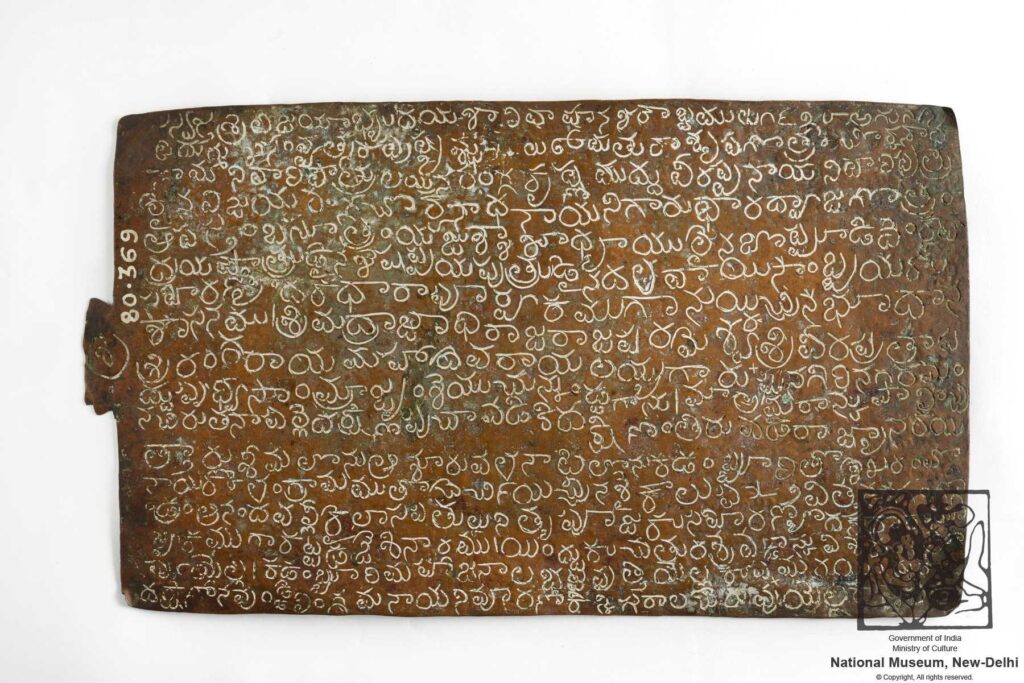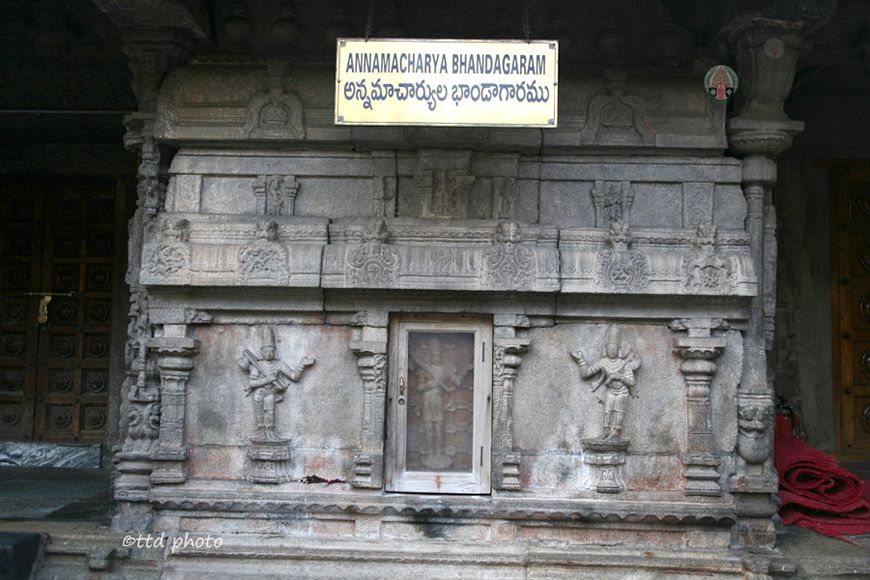Sankeerthana Bhandagaram
Adjacent to Sabhera’s room a south-facing room is there. This room has big pillars with beautiful carvings on them. This is known as Sankeerthana Bhandagaram. Some call this room by name Tallapaka Ara i.e., room. There is a board which says that this is Annamacharya Bhandagaram.
This Bhandagaram (treasury) room has wooden doors. On both sides of this entrance, you will find two statues pointing to this room. The statues have guitars (a stringed musical instrument) on their shoulders. The statue on the right side is that of Annamacharya and the statue on the left side is that of Peda Tirumalacharya. The statues and names are identified by the great scholar Late Sri Veturi Prabhakara Shastri Garu.
Poets of the Tallapaka Dynasty
Three poets of the Tallapaka dynasty Annamacharya, his son Peda Tirumalacharyulu, and his grandson China Tirumalacharyulu have composed songs in praise of Lord Venkateswara. They have also written Dandakas (prose hailing the deity) and shatakas (108 padyam’s i.e., Quatrains in praise of their family deity) in Telugu.
Ragi Rekula Ara / Sankeerthana Ara / Tallapaka Ara
Tallapaka poets took care to see that their Keerthanas were engraved on copper plates. These plates were safely preserved in the Sankeerthana Bhandagarams. Because the copper plates were preserved here, people began to call this Ragi Rekula Ara (Room containing copper plates) Sankeerthana Ara (room). As it had Sankeerthanas of Tallapaka poets some named it as Tallapaka Ara (room).
Now so many cassettes are available in the market. So many singers have sung and have been singing the compositions of Tallapaka poets. Almost every day live stage performances are given for all these things – audio and video. The main source for this is Bhandagaram i.e., treasury. This particular room has been playing an important role right from day one when administration of the temple was taken over by T.T.D.
Sankeerthana Bhandagaram room is serving as the hub of all Spiritual Activities of T.T.D. Because of these copper plates, Lord Venkateswara has become a Universal God. His temples are there in almost every important city of the world.
Annamaiah loudly challenges Lord Venkateswara in the following Keerthana.
Ne Nokkada Lekundithe Neekripaku Bathra Medi
Pooni Na Vallane Keerthi Pondevu Neevu
If I were not to be there people would not have come to know about Your Grace or Kindness. You owe Your name and fame to me.

Annamacharya
Annamacharya was a born ‘Advaithi’ i.e., a smartha. But he has worshipped the Vaishnavite God who is being worshipped by staunch Vaishnavite Acharyas. He participated religiously in all utsavas that are celebrated in Tirumala. He even got one room in the precincts of the temple. His statue is carved on the stone wall near the door of the room.
A Smartha becoming a Vaishnavite is a wonder. The wonder of wonders is he has participated in Vaishnavite rituals of the temple and having a statue engraved on the wall should be considered as the most wonderful thing.
Lord Venkateswara has addressed Annamaiah as Mama i.e., father-in-law. Even today during Kalyanotsavams that are performed Annamaiah happens to be Kanya Daata. According to popular belief, Annamaiah is the incarnation of Lord Venkateswara’s Nandaka Khadga. He has composed nearly 32 thousand keerthanas dealing with Yoga, Sringara, Vairagya etc.
Nobody has sung and composed songs on the Greatness, Generosity, Kindness, Benevolence, Bhaktha vatsalata, Saranagatha Vatsalya etc., of Lord of Seven Hills Sri Srinivasa, like Annamaiah. Even Puranas it seems have failed to explain His greatness. Where everybody has failed there Annamaiah has succeeded.
Annamaiah has this to say about his keerthanas:
“Please consider and preserve them as flowers offered to Your Lotus Feet. These are the flowers of Your Fame. Even if one sings only one sankeerthana that is sufficient for protecting him and blessing him. The other keerthanas please have them in your treasury.”
He i.e., Annamaiah has spent his entire life in the service of Lord Venkateswara.
Peda Tirumalacharya
He ordered his son Peda Tirumalacharya to compose at least one song per day in praise of Lord Venkateswara. Gracefully aged Annamaiah, on phalguna dwadashi day, in the year 1503 became one with his beloved God Lord Venkateswara. In one of his sankeerthanas he has emphasized that You i.e., Lord will protect us by listening to one song or keerthana.
When such is the case please have the other songs or sankeerthanas composed by me in Your treasury. This being the case he would have stored all his songs after getting a room constructed to store them.
Engraving Sankeerthanas on Copper Plates
Originally all his songs were written on dry palm leaves. To preserve them Annamaiah made arrangements for getting them engraved on copper plates. It is believed that the construction, of this temple room – Sankeerthana Bhandagaram would have been completed between the years 1523-30.
After completion of the construction, people would have preserved engraved copper plates of Annamaiah’s songs along with those of Peda Tirumalacharya, Annamaiah’s son, and China Tirumalacharya Annamaiah’s grandson.
It seems Vijayanagara emperor Achyuta Rayalu extended his helping hand to Annamaiah’s son Peda Tirumalacharyulu, in getting the sankeerthanas engraved on copper plates. The mention of Sankeerthana Bhandagaram is found in the inscription of 1541.
Sankeerthana Aralppadu
The inscription clearly says that the arrangements were made for proper lighting of the room – Sankeerthana Bhandagaram i.e., 24×7 lighting and distribution of ‘ATIRASALU’ a kind of sweet pancake to the devotees after naivedyam. On a very grand scale, even music performances were arranged in the name of ‘Sankeerthana Aralppadu’.
Kodai Tirunallu
Around 1545, it seems, during summer they used to celebrate “Kodai Tirunallu” (temple festival) for 20 days continuously. During this festival near Sankeerthana Bhandagaram, offerings were offered to the Lord. The available records reveal all these things.
Even to this day during Nitya Utsavam which starts on Ugadi and goes on for 40 days, near this room every day, Tallapaka Harati is performed to Malayappa Swamy.

Copper Plates
The copper plates that are preserved in this Sankeerthana Bhandagaram room are not of even size. As per their measurements, they are divided into four groups.
Ordinary plates or sheets (saadhaarana rekulu: Abbreviation: Sa.Re)
So far 2531 ordinary copper plates have been found. These plates belong to all the Tallapaka poets. They are approximately 15.5 inches long and 7 inches wide in their size. They used to keep them almost permanently in temples.
Big plates or sheets (pedda rekulu Abb.pe.re)
Only 36 sheets or plates have been secured so far. People call them Ragi Bandalu i.e., copper stones, or Banda Rekulu i.e., stone sheets. They are 28 inches long and 16 inches wide in size. 5 or 6 sheets are hooked together with a metal ring.
They used to put a rod through metal rings and carry them as if it is a palanquins to different places to propagate and popularize those keerthanas. Great renowned research scholar Sri Veturi Prabhakar Shastri went to Ahobila Kshethra and found them after some search.

Inscription sheets (Saasanapu Rekulu Abb.sa.re)
The total number of sheets procured is ten. Each sheet is 11 inches long and 8 inches wide in size. Even these plates are hooked (4 or 5 sheets in an iron ring) to iron rings.
Long sheets (Nidu Rekulu Abb.Ni.Re)
These sheets are like palm leaves in their size. They have found 119 sheets. Apart from these some incomplete pieces are also found. These sheets are 33 inches long and 2.5 inches wide in their size. Out of these sheets, some have been lost over a while. We have already given the number of copper sheets found after the search.
Even among these available sheets only ordinary sheets are arranged according to the names of poets.

